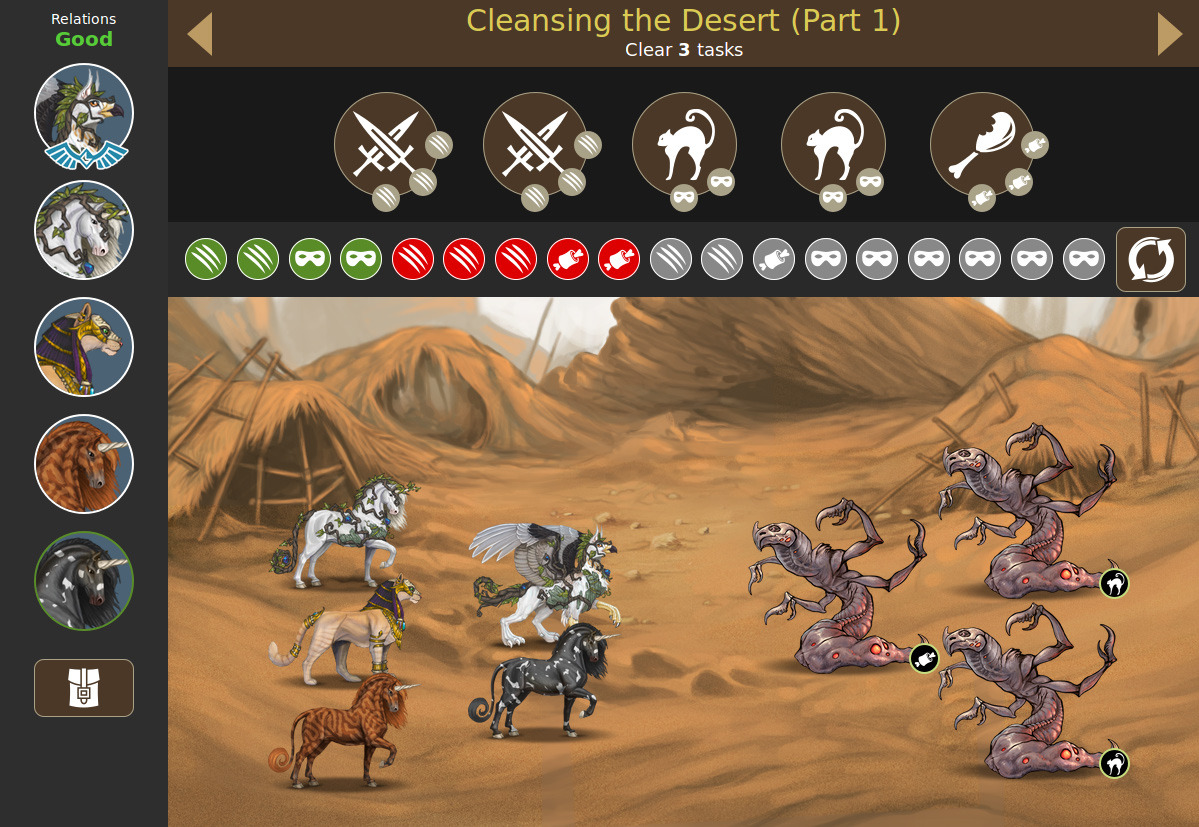Posted at 2016-11-14 02:05:10 — Link
The combat system is one of the core features for most of the video game genres. One of our main aims was to design a mechanics that would work equally good both for battles and for peaceful challenges like researching or diplomacy. This way we could substantially diversify the interactions with the game world, stepping away from just killing everything around and allowing a player to choose different tactics to achieve the game goals.
Inspired by the boardgames, we started from paper and dice prototyping. Boardgames are very successful in terms of abstract mechanics, so they are a good source to learn how to design your own.
Today we want to introduce you the mechanics behind our challenge system and UI preview of the challenge screen.

Let’s imagine that your party has encountered a group of three Mogeras. These subterranean creatures feel very uncomfortable on the surface where they were chased by hunger. You have a selection of 5 tasks: Fight these abominations, Scare them away or even Feed them. You need to fulfill 3 tasks to win this challenge.
Your party has a pool of available skill actions that depend both on the individual capabilities of each beast in the party and on the relationships between the party members. A player needs to choose the party members wisely as it may happen that one talented beast would be better than a constantly quarreling mob. Also note the fifth task, Feed. The required actions are not beast skills but resources – in this case, meat – that you can take from the inventory.
Mogeras are strong creatures, so a party needs 3 Attack actions for tasks 1 and 2. Although they are frightened and unaccustomed to the surface, so scaring them in tasks 3 and 4 will take only two Trick actions. Feeding them in task 5 takes 3 Meat items because Mogeras are very hungry and voracious.
An action can result in a success, a pass or a fail. By default, there are 6 outcomes for each action: 2 successes, 3 passes, and 1 fail. For example, the possible outcomes for an attack skill look like this:

Every outcome has the same chance, so there’s a 33% chance of a success, a 50% chance of a pass, and a 17% chance of a fail.
There can be more than one fail or only one success if a party member using that skill is ill, depressed or has another strong negative status.
The challenge is turn-based. Each turn starts with an attempt to successfully use all of the available skills and resources and ends with either fulfilling a task or switching to a new turn.
So you start a turn and get something like this for a full party with an ally (here we suppose that each of your beasts has 3 Attacks, 3 Tricks, and you used 5 Meat for this challenge):

The green color means a success, the gray is a pass and the red is a fail. You can use only the successes to fulfill the tasks by simple drag-n-dropping successful actions onto the task that you want to complete. The failed skills and materials are removed from the pool and can’t be used again. Passes can’t be used for dealing with the tasks at this turn, but they are not removed from the pool and can be used for another attempt.
Our party has 6 Tricks and 3 Attacks as successful this turn, so you may choose to close either a Fight or a Scare task. Usually, a party can finish only one task per turn. If there are not enough successes to handle any of the tasks, a player starts a new turn and makes a new attempt using all of the available skills and resources again. As you might guess, the pool will reduce with each attempt because of the fails. You lose the challenge when you’re out of skills and materials and you failed to fulfill the required number of tasks.

This all would be kind of dull and look like “click a button until you get what you need” game, but we have a number of additional modifiers that provide enough possibilities for different tactics.
1) Additional Actions. Actions that can be performed by a player until the end of the turn. One of such actions is available for all beasts. It is Concentration which allows you to discard one skill or resource from the pool to keep the outcome of a chosen skill or resource for the next turn.
There’s a variety of other Additional Actions which aren’t available by default and depend on the genetics, professions, and other quirks. Certain beasts can have a possibility to:
- alter the turn outcomes by making different kinds of additional attempts
- allow to finish a few tasks within one turn
- provide automatic successes etc.
The similar modifiers can be provided by artifacts in the inventory of a party.
2) Instant Actions. These actions are automatically triggered when a certain condition is met. For example, one of the party members has a Looney Genius perk. Each time when a player fails to finish a task and doesn’t choose Concentration additional action at the end of the turn, there’s a chance that a Looney Genius will go into a rush mode. Each skill of this beast in a rush mode gets one more success and one more fail, so now there’s 50% chance to get a success and 33% to get a fail from each skill until the end of the challenge. This beast also doesn’t discard a skill or a resource for Concentration.

Attack skill outcomes affected by the rush mode
3) Special Conditions. A variety of modifiers that doesn’t fall under the previous two categories. Here are some of them:
- Fails may trigger unpleasant consequences like wounds for party members
- Tasks must be finished in a certain order
- Skill pool is restricted. For example, party members interfere with each other, when investigating a small cave. N random skills are removed from the pool where N depends on how many members are in a party.
- Random skills get a decreased success chance or an increased fail chance etc.
We hope to hear your thoughts about this system!
Thank you for reading! :)




